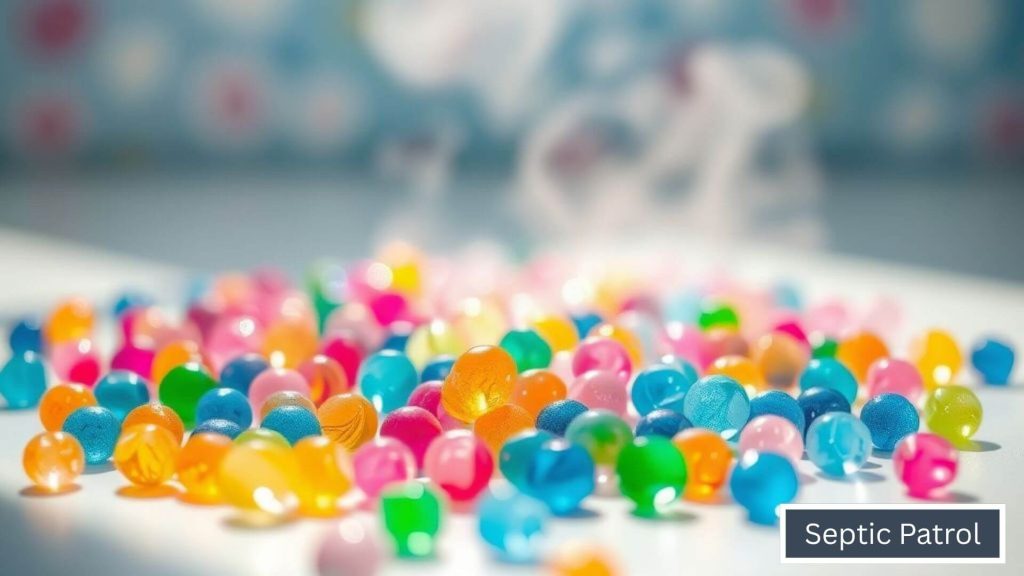
Laundry scent boosters have surged in popularity, promising long-lasting fragrance and a fresh-from-the-dryer aroma that lingers for weeks. Products like Downy Unstopables, Purex Crystals, and Gain Fireworks have become laundry staples in many American households. But if your home relies on a septic system, you might want to think twice before tossing those fragrance beads into your wash.
Scent boosters, though seemingly harmless, can pose significant risks to the delicate balance of your septic tank ecosystem, especially if used frequently. While they may leave your clothes smelling like a tropical breeze or a spring meadow, they could be quietly undermining the health of your septic system — and potentially the environment.
What’s Inside a Scent Booster?
Most commercial scent boosters consist of a handful of potent ingredients:
- Synthetic fragrance oils (usually proprietary blends)
- Plastic-based or salt-based carrier agents like polyethylene glycol (PEG), sodium sulfate, or PET
- Microencapsulation polymers to extend scent life
- Stabilizers and dyes
These ingredients are not just complex — some are often non-biodegradable, oil-based, and toxic to beneficial bacteria that your septic system relies on.
Why Your Septic System May Suffer
Your septic tank depends on a thriving colony of bacteria to break down organic waste. Anything that disrupts this biological balance can spell trouble — and frequent or excessive scent boosters may do just that.
1. Antibacterial Effects
Some of the chemical components used in some scent capsules have antimicrobial properties. While that’s great for killing odor on clothes, it’s bad news for your septic tank. These agents inhibit or kill the good bacteria, slowing down waste decomposition and leading to sludge buildup.
2. Petroleum-Based Fragrance Carriers
Like traditional fabric softeners, many scent boosters are essentially oil-based. These oils behave like FOGs (fats, oils, and greases) once they enter your plumbing. They rise to the top of your tank, contributing to the scum layer. Over time, this layer can become too thick, overwhelm the system, and clog your drainfield — a critical component of septic function.
3. Non-Biodegradable Microbeads and Polymers
Plastic-like encapsulating agents do not easily break down. When flushed into the septic tank, they persist in the effluent, increase the risk of solids escaping into the drainfield, and may even contribute to clogs or complete system failure over time.
4. Disruption of Settling Layers
The emulsifiers and surfactants in some scent boosters can interfere with the natural separation of solids, liquids, and scum inside the tank. This causes solids to remain suspended in the wastewater, leading to contamination of the drainfield — which is not designed to handle solid waste.
Safe Scent Alternatives for Septic Owners
If you love fresh-smelling laundry but care about your septic system (and your wallet), there are septic-safe alternatives that won’t harm your home’s wastewater treatment:
1. Essential Oils and Vinegar
Add 10–15 drops of your favorite essential oil (like lavender or lemon) to ½ cup of distilled white vinegar in the rinse cycle. This will soften clothes and lightly scent them without synthetic chemicals.
2. Scented Dryer Balls
Wool dryer balls can be infused with essential oils and tossed in the dryer for natural fragrance and static reduction. They’re reusable, chemical-free, and safe for your system.
3. Eco-Friendly Boosters
Look for plant-based, biodegradable laundry boosters marketed as septic-safe — such as Molly’s Suds Laundry Boosters or Method Fragrance Boosters. Always check labels for septic-safe or biodegradable assurances.
Recommended: Septic-Safe Toilet Bowl Cleaners: 18 Products Reviewed